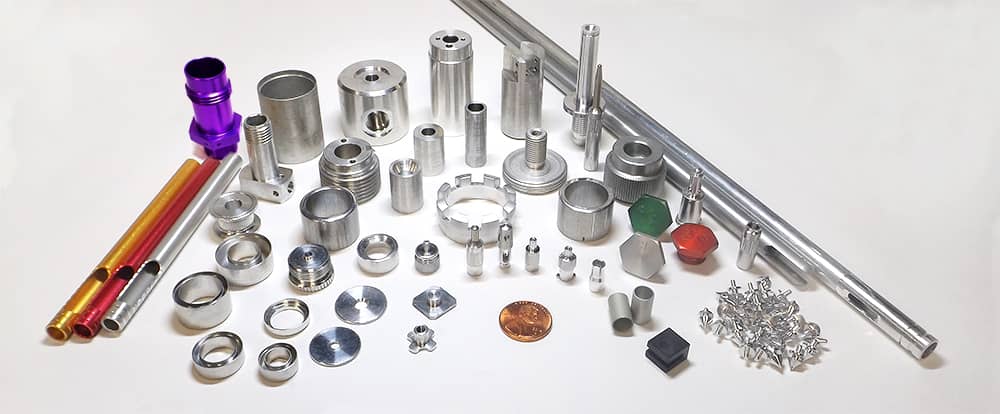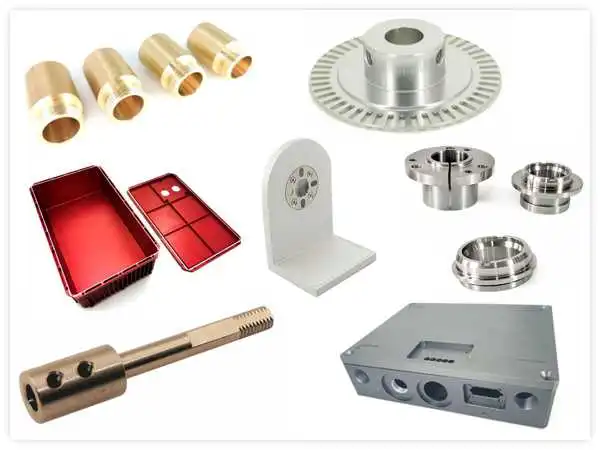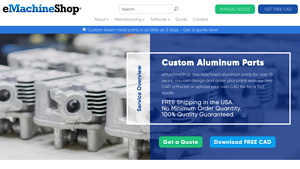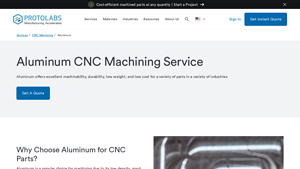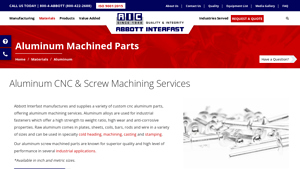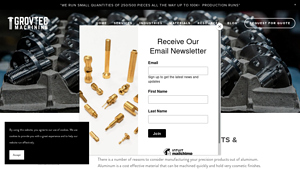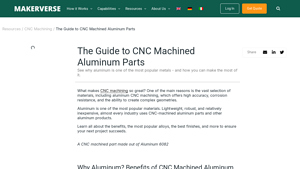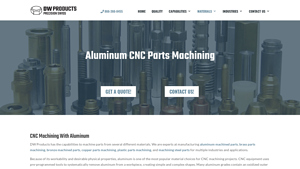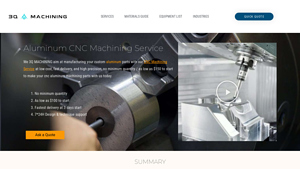Aluminium Machined Parts Guide: Type, Cost, Top List…
Introduction: Navigating the Global Market for aluminium machined parts
In today’s competitive landscape, sourcing high-quality aluminium machined parts poses a significant challenge for international B2B buyers. The need for lightweight, durable, and cost-effective components is paramount across diverse industries, from automotive to aerospace. This guide offers a comprehensive exploration of aluminium machined parts, addressing critical factors such as material selection, machining processes, and the myriad applications that make aluminium indispensable in modern manufacturing.
Buyers will gain insights into various aluminium alloys, their unique properties, and the advantages they bring to specific applications, helping them make informed decisions tailored to their operational needs. The guide also emphasizes the importance of supplier vetting, providing strategies to assess potential partners effectively, ensuring that quality, reliability, and cost-efficiency are prioritized.
By delving into the nuances of pricing structures, machining capabilities, and finishing options, this guide empowers B2B buyers from Africa, South America, the Middle East, and Europe—including key markets like Brazil and Vietnam—to navigate the global market with confidence. Whether you are looking to innovate in product design or streamline production processes, understanding the intricacies of aluminium machined parts will enhance your purchasing strategy and drive business success.
Understanding aluminium machined parts Types and Variations
| Type Name | Key Distinguishing Features | Primary B2B Applications | Brief Pros & Cons for Buyers |
|---|---|---|---|
| CNC Machined Parts | High precision and repeatability | Aerospace, automotive, industrial machinery | Pros: High accuracy, customizable; Cons: Higher initial cost, longer lead times. |
| Extruded Parts | Produced through shaping aluminum billets | Construction, automotive, consumer products | Pros: Cost-effective for high volumes; Cons: Limited to specific shapes. |
| Anodized Parts | Enhanced corrosion resistance and aesthetics | Electronics, automotive, marine applications | Pros: Durable finish, improved appearance; Cons: Additional processing time and cost. |
| Forged Parts | Increased strength through deformation | Aerospace, military, automotive components | Pros: Superior strength; Cons: Higher manufacturing cost and complexity. |
| Cast Parts | Formed by pouring molten aluminum into molds | Consumer goods, automotive, machinery parts | Pros: Complex shapes achievable; Cons: Lower strength compared to other methods. |
What Are CNC Machined Parts and Their Characteristics?
CNC machined parts are highly precise components produced using Computer Numerical Control (CNC) machines. These parts are favored for their exceptional accuracy, allowing for tight tolerances and intricate designs. They are suitable for high-performance applications in industries such as aerospace, automotive, and industrial machinery. When purchasing CNC machined parts, buyers should consider factors like material availability, machining tolerances, and lead times, as these can significantly impact production schedules and costs.
How Do Extruded Parts Stand Out in the Market?
Extruded aluminum parts are created by forcing aluminum through a die to obtain specific cross-sectional shapes. This method is particularly cost-effective for large production runs, making it ideal for construction materials, automotive components, and consumer products. Buyers should evaluate the required shape and volume, as extrusion is most efficient for consistent, high-volume orders. However, the design flexibility is limited compared to other machining processes, which could restrict customization.
What Are the Benefits of Anodized Parts for Businesses?
Anodized aluminum parts undergo an electrochemical process that enhances their corrosion resistance and surface finish. This is particularly important in industries like electronics and automotive, where durability and aesthetics are paramount. Buyers should consider the type of anodizing required—Type I, II, or III—based on the application’s performance needs. While anodizing adds value, it can also increase lead times and costs, making it essential to balance these factors against the benefits.
Why Choose Forged Parts for High-Stress Applications?
Forged aluminum parts are manufactured through a process that deforms the metal under high pressure, resulting in enhanced strength and durability. These parts are commonly used in demanding sectors such as aerospace and military applications. When sourcing forged parts, buyers should assess the specific strength requirements and potential applications to ensure the right choice. However, the complexity of the forging process can lead to higher costs, which may impact budget considerations.
What Are the Advantages and Limitations of Cast Parts?
Cast aluminum parts are made by pouring molten aluminum into molds, allowing for the creation of complex shapes. This method is beneficial for producing intricate designs in consumer goods, automotive components, and machinery parts. Buyers should weigh the advantages of design flexibility against the potential for lower strength compared to other manufacturing methods. Additionally, the initial setup costs for casting can be high, making it more suitable for specific applications rather than mass production.
Key Industrial Applications of aluminium machined parts
| Industry/Sector | Specific Application of Aluminium Machined Parts | Value/Benefit for the Business | Key Sourcing Considerations for this Application |
|---|---|---|---|
| Aerospace | Aircraft components (e.g., fuselage frames) | Lightweight and high strength enhance fuel efficiency | Compliance with stringent safety regulations and standards |
| Automotive | Engine components and chassis parts | Reduced weight leads to improved fuel economy | Need for precision and reliability in high-stress environments |
| Electrical & Electronics | Enclosures for electronic devices | Excellent thermal conductivity aids in heat dissipation | Importance of corrosion resistance and surface finishes |
| Construction | Structural components for buildings | Corrosion resistance and lightweight properties reduce costs | Customization options for specific architectural designs |
| Marine | Hull and structural parts for vessels | Enhanced strength-to-weight ratio improves performance | Resistance to marine corrosion is critical for longevity |
How Are Aluminium Machined Parts Used in the Aerospace Industry?
In the aerospace sector, aluminium machined parts are crucial for manufacturing components such as fuselage frames and wing structures. The lightweight nature of aluminium allows for significant fuel savings and improved payload capacities. International buyers must consider compliance with strict aviation regulations, ensuring that all machined parts meet safety standards and specifications. Additionally, sourcing from suppliers who can provide high-quality alloys like 6061 and 7075 is essential for maintaining structural integrity under extreme conditions.
What Role Do Aluminium Machined Parts Play in the Automotive Sector?
Aluminium machined parts are extensively used in the automotive industry for components such as engine blocks, transmission housings, and chassis parts. The use of aluminium contributes to reducing the overall vehicle weight, which directly improves fuel efficiency and lowers emissions. B2B buyers should prioritize suppliers who can offer precision machining to meet the high tolerances required in automotive applications. Furthermore, understanding the specific aluminium alloys best suited for high-stress automotive components is vital for optimal performance.
How Are Aluminium Machined Parts Beneficial in Electrical and Electronics Applications?
In the electrical and electronics industry, aluminium machined parts are widely used for creating enclosures and heat sinks for devices. Aluminium’s excellent thermal conductivity helps dissipate heat efficiently, ensuring optimal performance of electronic components. Buyers in this sector should focus on sourcing parts that are not only precisely machined but also treated for corrosion resistance, especially for applications in humid or corrosive environments. Additionally, surface finishes like anodizing can enhance aesthetics and durability.
What Advantages Do Aluminium Machined Parts Offer in Construction?
Aluminium machined parts play a significant role in construction, particularly in structural components like beams and frames. Their lightweight and corrosion-resistant properties make them ideal for both new builds and renovations, especially in regions prone to seismic activity. International buyers should consider the customization capabilities of suppliers to meet specific architectural requirements. Moreover, understanding local building codes and standards is essential to ensure compliance and safety in construction applications.
Why Are Aluminium Machined Parts Important in the Marine Industry?
In the marine sector, aluminium machined parts are utilized for hulls and structural components of vessels, benefiting from their high strength-to-weight ratio and resistance to corrosion from saltwater. This enhances the performance and longevity of marine vessels. Buyers need to ensure that the sourced parts are manufactured from marine-grade aluminium alloys and have undergone appropriate finishing processes to withstand harsh marine environments. Additionally, suppliers should provide assurance of quality and compliance with maritime regulations to prevent costly failures.
3 Common User Pain Points for ‘aluminium machined parts’ & Their Solutions
Scenario 1: Navigating Supply Chain Disruptions for Aluminium Parts
The Problem: B2B buyers in regions like Africa and South America often face significant challenges due to supply chain disruptions. Factors such as political instability, poor infrastructure, and global market fluctuations can lead to delays in the sourcing of aluminium machined parts. These delays not only affect production schedules but can also lead to increased costs as companies scramble to find alternative suppliers or expedite shipping. The uncertainty surrounding delivery timelines creates frustration and impacts the overall operational efficiency of businesses relying on timely access to components.
The Solution: To mitigate supply chain issues, buyers should diversify their supplier base and consider regional suppliers who can provide shorter lead times. Establishing relationships with multiple manufacturers can create a buffer against disruptions. Furthermore, leveraging local suppliers who have a better understanding of the regional challenges can lead to more reliable sourcing. It is essential to conduct thorough due diligence by assessing the supplier’s reliability, capacity, and past performance. Additionally, implementing a robust inventory management system that anticipates demand fluctuations can help maintain stock levels and reduce reliance on just-in-time deliveries. By proactively managing supplier relationships and maintaining a strategic inventory, companies can significantly enhance their resilience to supply chain disruptions.
Scenario 2: Ensuring Quality Control in Aluminium Machined Parts
The Problem: Quality control is a major concern for B2B buyers when procuring aluminium machined parts, especially for critical applications in industries such as aerospace and automotive. Variability in quality can lead to defective components, resulting in costly reworks, delays, and potential safety hazards. Buyers may struggle with inconsistent quality across batches, particularly when sourcing from multiple suppliers or overseas manufacturers.
The Solution: To ensure high-quality standards, buyers should implement a comprehensive quality assurance process that includes detailed specifications for the aluminium parts being ordered. This should encompass tolerances, surface finish requirements, and testing standards. Collaborating with suppliers that provide transparent quality metrics and certifications, such as ISO 9001, can also enhance confidence in product quality. Additionally, buyers should consider conducting regular audits of their suppliers’ facilities and processes to ensure compliance with their quality expectations. Utilizing advanced technologies such as 3D printing for prototyping can also help in validating designs before full-scale production, thereby reducing the risk of defects in the final products. Establishing a feedback loop with suppliers to address quality issues promptly can lead to continuous improvement and stronger partnerships.
Scenario 3: Selecting the Right Aluminium Alloy for Specific Applications
The Problem: Many B2B buyers encounter difficulties in selecting the appropriate aluminium alloy for their specific applications, which can lead to suboptimal performance of the final product. With various alloys available, each possessing distinct properties related to strength, corrosion resistance, and machinability, making the wrong choice can result in higher costs, increased weight, or even product failure in critical applications.
The Solution: Buyers should take a systematic approach to selecting the right aluminium alloy by clearly defining the requirements of their application. Factors to consider include mechanical properties such as tensile strength and elongation, environmental conditions (e.g., exposure to moisture or chemicals), and the specific manufacturing processes involved. Consulting with suppliers who offer expertise in material selection can provide valuable insights. Additionally, utilizing resources like datasheets and case studies can inform the decision-making process. Engaging in collaborative discussions with suppliers during the design phase can ensure that the chosen alloy aligns with both functional and cost objectives. Testing prototypes made from selected alloys before full-scale production can further validate the suitability of the material and reduce the risk of costly mistakes. By prioritizing informed material selection, companies can enhance product performance and longevity while optimizing manufacturing processes.
Strategic Material Selection Guide for aluminium machined parts
What Are the Key Properties of Common Aluminum Alloys for Machined Parts?
When selecting materials for aluminum machined parts, understanding the properties of various aluminum alloys is crucial for ensuring optimal performance in specific applications. Below are analyses of four common aluminum alloys used in B2B manufacturing.
Aluminum 6061: Versatile and Cost-Effective
Key Properties: Aluminum 6061 is known for its excellent corrosion resistance, good mechanical properties, and weldability. It can withstand temperatures up to 150°C (302°F) and offers a good balance of strength and weight.
Pros & Cons: This alloy is relatively easy to machine, making it a popular choice across various industries. However, it may not be as strong as other alloys like 7075, which could limit its use in high-stress applications. Additionally, while it is cost-effective, its mechanical properties can vary based on the temper.
Impact on Application: Aluminum 6061 is suitable for applications in automotive, aerospace, and construction due to its versatility. It is often used for structural components, frames, and fittings.
Considerations for International Buyers: Buyers from regions such as Africa and South America should ensure compliance with local standards such as ASTM or DIN. The alloy’s availability may vary by region, impacting lead times and costs.
Aluminum 7075: High Strength for Demanding Applications
Key Properties: Aluminum 7075 is known for its high strength-to-weight ratio, making it ideal for applications that require durability. It can handle temperatures up to 120°C (248°F) and has excellent fatigue resistance.
Pros & Cons: While 7075 offers superior strength, it is more expensive than other alloys and can be more challenging to machine. Additionally, it is not as corrosion-resistant, which may necessitate protective coatings in certain environments.
Impact on Application: This alloy is commonly used in aerospace and military applications, where strength and weight are critical. It is often found in aircraft components, marine structures, and high-stress automotive parts.
Considerations for International Buyers: Compliance with military and aerospace standards (e.g., MIL-STD) is essential for buyers in the Middle East and Europe. The higher cost may also impact budget considerations for projects in developing regions.
Aluminum 5052: Corrosion Resistance for Marine and Industrial Use
Key Properties: Aluminum 5052 is highly resistant to corrosion, especially in marine environments, and can withstand temperatures up to 65°C (149°F). It offers good weldability and formability.
Pros & Cons: This alloy is excellent for applications requiring bending and shaping, making it a favorite for sheet metal fabrication. However, its strength is lower compared to 6061 and 7075, which may limit its use in heavy-load applications.
Impact on Application: Aluminum 5052 is widely used in marine applications, automotive fuel tanks, and pressure vessels due to its corrosion resistance.
Considerations for International Buyers: Buyers should be aware of regional regulations regarding marine materials. Compliance with standards like ASTM B928 is critical for ensuring product quality in marine applications.
Aluminum 2024: High Strength with Limitations
Key Properties: Aluminum 2024 is known for its high strength and fatigue resistance, suitable for applications requiring a high strength-to-weight ratio. It can withstand temperatures up to 150°C (302°F) but has limited corrosion resistance.
Pros & Cons: This alloy is excellent for aerospace applications due to its strength but is not weldable, which may limit its versatility. Its susceptibility to corrosion means it often requires protective coatings.
Impact on Application: Commonly used in aircraft structures, 2024 is ideal for components under high stress but may not be suitable for environments exposed to moisture or corrosive elements.
Considerations for International Buyers: Buyers in Europe and the Middle East should ensure compliance with aerospace standards, as well as consider the need for protective measures against corrosion.
Summary Table of Aluminum Alloys for Machined Parts
| Material | Typical Use Case for aluminium machined parts | Key Advantage | Key Disadvantage/Limitation | Relative Cost (Low/Med/High) |
|---|---|---|---|---|
| Aluminum 6061 | Structural components, automotive parts | Excellent corrosion resistance | Lower strength compared to 7075 | Medium |
| Aluminum 7075 | Aerospace, military components | High strength-to-weight ratio | Higher cost, difficult to machine | High |
| Aluminum 5052 | Marine applications, fuel tanks | Exceptional corrosion resistance | Lower strength compared to 6061 | Medium |
| Aluminum 2024 | Aircraft structures, high-stress components | High strength and fatigue resistance | Limited corrosion resistance | High |
This analysis provides a strategic overview for international B2B buyers, enabling informed decisions when selecting aluminum alloys for machined parts based on specific application needs and regional considerations.
In-depth Look: Manufacturing Processes and Quality Assurance for aluminium machined parts
What Are the Main Stages of Manufacturing Aluminium Machined Parts?
The manufacturing of aluminium machined parts involves several critical stages that ensure precision, quality, and efficiency. Understanding these stages can help B2B buyers make informed decisions when sourcing parts for their projects.
Material Preparation: How Is Aluminium Processed Before Machining?
The first step in the manufacturing process is material preparation. Aluminium is typically supplied in the form of sheets, plates, or bars, often as an alloy to enhance its mechanical properties. Common alloys include 6061, 7075, and 2024, each chosen based on the specific application requirements.
The preparation phase may include cutting the aluminium to size, removing any surface contaminants, and ensuring the material is free from defects. This stage is crucial because it sets the foundation for the subsequent machining operations.
Forming: What Techniques Are Used to Shape Aluminium Parts?
After preparing the material, the next stage is forming, where various machining techniques are employed to achieve the desired shapes and dimensions. The most common methods include:
- CNC Milling: Utilizes rotating cutting tools to remove material and create complex geometries. This method is ideal for producing intricate parts with tight tolerances.
- CNC Turning: Involves rotating the aluminium workpiece against a stationary cutting tool to produce cylindrical shapes. This technique is often used for components like shafts and fittings.
- Waterjet Cutting: Employs high-pressure water streams mixed with abrasives to cut through the material, allowing for intricate designs without affecting the material’s integrity.
- EDM (Electrical Discharge Machining): Uses electrical sparks to erode material, perfect for creating precise features in hard-to-machine alloys.
Each of these techniques has its advantages and is chosen based on the part’s complexity, size, and intended application.
Assembly: How Are Machined Parts Joined Together?
In many cases, machined parts require assembly. This can involve various methods, such as welding, riveting, or using mechanical fasteners. The choice of assembly method depends on the application and the mechanical properties required. For instance, welding may be preferred for high-strength applications, while mechanical fasteners might be suitable for parts that need to be disassembled for maintenance.
Finishing: What Surface Treatments Enhance Aluminium Parts?
Finishing is the final stage in the manufacturing process and is crucial for enhancing the appearance and performance of aluminium parts. Common finishing processes include:
- Anodizing: This electrochemical process creates a protective oxide layer, increasing corrosion resistance and surface hardness while allowing for dyeing.
- Powder Coating: Involves applying a dry powder that is then cured under heat to form a durable finish. This method is popular for its aesthetic appeal and durability.
- Polishing: A mechanical process that enhances the surface finish, making it smoother and more reflective.
These finishing techniques not only improve the visual appeal of the parts but also extend their lifespan and functionality.
What Quality Assurance Practices Should B2B Buyers Expect?
Quality assurance (QA) is a vital aspect of the manufacturing process for aluminium machined parts. It ensures that products meet specified standards and perform reliably in their intended applications.
Which International Standards Are Relevant for Aluminium Machining?
Many international standards govern the quality of manufactured parts, with ISO 9001 being one of the most widely recognized. This standard outlines requirements for a quality management system and emphasizes customer satisfaction and continuous improvement. Other industry-specific standards may include:
- CE Marking: Indicates compliance with European safety, health, and environmental protection standards.
- API (American Petroleum Institute): Sets standards for equipment used in the oil and gas industry, ensuring safety and reliability.
B2B buyers should verify that their suppliers adhere to these standards, as compliance reflects a commitment to quality and customer satisfaction.
What Are the Key Quality Control Checkpoints?
Quality control (QC) is implemented at various stages of the manufacturing process through checkpoints known as:
- Incoming Quality Control (IQC): Inspects raw materials upon receipt to ensure they meet specified standards before processing begins.
- In-Process Quality Control (IPQC): Monitors the manufacturing process in real-time, ensuring that the machining operations adhere to predetermined specifications.
- Final Quality Control (FQC): Conducts thorough inspections of the finished products, including dimensional checks, surface finish evaluations, and functional tests.
These checkpoints help identify defects early in the process, reducing waste and ensuring that only high-quality parts reach the customer.
What Testing Methods Are Commonly Used for Quality Assurance?
Several testing methods are employed to ensure the integrity and performance of aluminium machined parts. Common techniques include:
- Dimensional Inspection: Utilizes tools like calipers and coordinate measuring machines (CMM) to verify that parts meet specified dimensions and tolerances.
- Material Testing: Assesses the mechanical properties of the aluminium, such as tensile strength and hardness, often performed through standardized tests.
- Non-Destructive Testing (NDT): Techniques like ultrasonic testing or dye penetrant inspection are used to detect internal defects without damaging the part.
These testing methods provide assurance that the parts will perform as expected in their applications.
How Can B2B Buyers Verify Supplier Quality Control?
For B2B buyers, especially those in international markets, verifying a supplier’s quality control processes is essential. Here are some actionable steps:
- Supplier Audits: Conducting regular audits of potential suppliers can provide insights into their quality control practices and adherence to standards.
- Requesting Quality Reports: Suppliers should be willing to share documentation related to their quality management systems and inspection results.
- Third-Party Inspections: Engaging third-party inspection services can provide an unbiased assessment of the supplier’s quality processes and product conformity.
What Are the QC and Certification Nuances for International B2B Buyers?
International B2B buyers must navigate specific nuances in quality control and certification when sourcing aluminium machined parts. Different regions may have varying regulations and standards, making it crucial to understand local compliance requirements. For instance, buyers from Europe must ensure that their suppliers meet CE marking requirements, while those in the Middle East may need to adhere to specific local standards.
Additionally, language barriers and cultural differences may affect communication regarding quality expectations. Establishing clear specifications and maintaining open communication channels can mitigate these challenges.
By understanding the manufacturing processes and quality assurance practices involved in aluminium machined parts, B2B buyers can make more informed decisions and secure high-quality components that meet their needs.
Practical Sourcing Guide: A Step-by-Step Checklist for ‘aluminium machined parts’
Introduction
This practical sourcing guide serves as a comprehensive checklist for B2B buyers seeking to procure aluminum machined parts. With a focus on efficiency and quality, the steps outlined here will help you navigate the complexities of sourcing, ensuring that you partner with the right suppliers to meet your specific manufacturing needs.
1. Define Your Technical Specifications
Before initiating the sourcing process, clearly define the technical specifications of the aluminum machined parts you require. This includes dimensions, tolerances, and material grades. Precise specifications will guide your conversations with suppliers and help ensure that the final product meets your expectations.
2. Identify Suitable Aluminum Alloys
Different aluminum alloys offer unique properties that suit various applications. Familiarize yourself with options such as 6061, 7075, and 2024, which vary in strength, corrosion resistance, and machinability. Selecting the right alloy is crucial for ensuring the performance and longevity of your parts.
3. Evaluate Potential Suppliers
Thoroughly vet potential suppliers before making a commitment. Request company profiles, case studies, and references from other clients in similar industries or regions. Look for suppliers with experience in your specific application area, as this can significantly impact the quality of the parts produced.
4. Verify Supplier Certifications
Ensure that your potential suppliers hold relevant certifications, such as ISO 9001 or AS9100, which indicate adherence to quality management standards. Certifications not only demonstrate a commitment to quality but also assure you that the supplier meets international manufacturing standards.
5. Request and Review Quotes
After narrowing down your list of suppliers, request detailed quotes. A good quote should include not just pricing but also lead times, shipping options, and payment terms. Compare these aspects across different suppliers to identify the best overall value, rather than just the lowest price.
6. Assess Manufacturing Capabilities
Investigate the manufacturing capabilities of your shortlisted suppliers. This includes understanding their machinery, technology, and processes, such as CNC machining, waterjet cutting, or laser cutting. A supplier with advanced capabilities can offer higher precision and flexibility in production, which can be crucial for complex designs.
7. Discuss Quality Control Processes
Engage with suppliers to understand their quality control measures. Inquire about inspection processes, testing methods, and how they handle defects. A robust quality control system ensures that the parts you receive meet your specifications and are free from defects, reducing the risk of costly production delays.
By following this checklist, you can streamline your sourcing process for aluminum machined parts, ensuring that you partner with reliable suppliers who can deliver quality components that meet your operational needs.
Comprehensive Cost and Pricing Analysis for aluminium machined parts Sourcing
When sourcing aluminum machined parts, understanding the cost structure is crucial for international B2B buyers. Here, we break down the key cost components and pricing influencers, along with actionable tips for optimizing procurement.
What Are the Key Cost Components for Aluminum Machined Parts?
-
Materials: The type of aluminum alloy significantly impacts the cost. Common alloys like 6061, 7075, and 2024 vary in price due to their unique properties and applications. For instance, 7075 is often more expensive due to its high strength and lower weight, making it suitable for aerospace applications.
-
Labor: Labor costs can fluctuate based on geographical location and the complexity of machining processes. Regions with a skilled workforce may offer competitive rates, but labor-intensive processes will naturally increase costs.
-
Manufacturing Overhead: This includes expenses related to facilities, utilities, and equipment maintenance. Suppliers may pass these costs onto buyers, particularly if they are operating in regions with higher operational costs.
-
Tooling: Initial tooling costs can be substantial, especially for custom parts. This includes the expense of creating molds or specialized equipment. However, these costs can be amortized over large production runs, making them less significant on a per-unit basis.
-
Quality Control (QC): Ensuring that parts meet specific standards can add to costs. Buyers should seek suppliers with robust QC processes, as this can prevent costly reworks or failures in the supply chain.
-
Logistics: Shipping and handling expenses can vary widely based on the origin, destination, and shipping terms. International buyers need to consider customs duties, insurance, and freight costs in their total procurement budget.
-
Margin: Suppliers typically include a profit margin in their pricing. This can vary based on market demand, competition, and the supplier’s business model.
How Do Pricing Influencers Affect the Cost of Aluminum Machined Parts?
-
Volume and Minimum Order Quantity (MOQ): Larger orders often lead to reduced per-unit costs due to economies of scale. Buyers should negotiate MOQs that suit their needs without incurring unnecessary costs.
-
Specifications and Customization: Custom parts with unique specifications generally incur higher costs due to the additional engineering and production time required. Standardized parts are typically less expensive and can be sourced more easily.
-
Material Quality and Certifications: Parts that require specific certifications (like aerospace-grade materials) will often be priced higher. Buyers should assess whether these certifications are necessary for their applications.
-
Supplier Factors: The supplier’s reputation, location, and capabilities can influence pricing. Established suppliers may command higher prices due to their reliability, while newer entrants might offer competitive rates to gain market share.
-
Incoterms: The agreed-upon Incoterms can affect overall costs. Terms like FOB (Free on Board) or CIF (Cost, Insurance, and Freight) dictate who is responsible for shipping costs and risks, which can significantly alter the total cost of ownership.
What Are Some Buyer Tips for Cost-Efficiency in Sourcing Aluminum Machined Parts?
-
Negotiate Wisely: Leverage volume purchases and long-term contracts to negotiate better pricing. Establishing a good relationship with suppliers can lead to favorable terms.
-
Consider Total Cost of Ownership (TCO): Evaluate the total cost beyond the purchase price. This includes potential rework, shipping, and quality assurance costs. A lower upfront price may not always translate to long-term savings.
-
Understand Pricing Nuances for International Sourcing: Buyers from regions like Africa, South America, the Middle East, and Europe should be aware of currency fluctuations, import duties, and regional trade agreements that can impact costs.
-
Request Quotes from Multiple Suppliers: Gathering quotes from various suppliers allows for better comparison and understanding of market rates. This practice can reveal pricing discrepancies and provide leverage in negotiations.
Conclusion
While the costs associated with aluminum machined parts can vary widely based on numerous factors, informed buyers can optimize their sourcing strategies to achieve better pricing and value. Understanding the intricate cost structure and leveraging negotiation tactics will ultimately lead to more successful procurement outcomes. Always remember that prices can fluctuate, and it’s advisable to request indicative quotes to ensure that your sourcing decisions are based on the most current market conditions.
Alternatives Analysis: Comparing aluminium machined parts With Other Solutions
Introduction: Understanding Alternative Solutions to Aluminium Machined Parts
In the landscape of manufacturing and component production, aluminium machined parts are a popular choice due to their lightweight, high strength-to-weight ratio, and excellent machinability. However, there are various alternatives that businesses can consider based on specific needs, applications, and budget constraints. This section will compare aluminium machined parts with other viable solutions, such as plastic injection molded parts and titanium machined components, to help B2B buyers make informed decisions.
Comparison Table
| Comparison Aspect | Aluminium Machined Parts | Plastic Injection Molded Parts | Titanium Machined Components |
|---|---|---|---|
| Performance | High strength, durable | Good for complex shapes, less durable than aluminum | Exceptional strength and corrosion resistance |
| Cost | Moderate | Generally lower, especially for high volumes | Higher due to raw material cost |
| Ease of Implementation | Requires CNC machining expertise | Faster production for large runs, limited to molds | Requires specialized machining knowledge |
| Maintenance | Low maintenance, corrosion-resistant | Moderate, depending on environmental exposure | Low, but can be challenging to repair |
| Best Use Case | Aerospace, automotive, marine | Consumer products, packaging, automotive parts | Aerospace, medical implants, high-performance applications |
Detailed Breakdown of Alternatives
Plastic Injection Molded Parts
Plastic injection molding is a widely used manufacturing process that allows for the creation of complex shapes and designs. While the initial setup costs for molds can be significant, the per-unit cost decreases dramatically with high production volumes, making it a cost-effective solution for large-scale manufacturing. However, plastic parts generally do not offer the same durability and strength as aluminium, which can limit their application in high-stress environments. They also require careful consideration of environmental factors, as certain plastics can degrade over time when exposed to UV light or extreme temperatures.
Titanium Machined Components
Titanium is renowned for its superior strength, lightweight nature, and excellent corrosion resistance, making it ideal for demanding applications such as aerospace and medical implants. However, titanium is considerably more expensive than aluminium, both in terms of raw materials and machining costs. The machining process for titanium also requires specialized tools and techniques due to its hardness, which can increase lead times. While titanium offers high performance, its cost and complexity may be prohibitive for many standard applications where aluminium would suffice.
Conclusion: How to Choose the Right Solution for Your Needs
When selecting between aluminium machined parts and alternative solutions like plastic injection molded parts or titanium machined components, B2B buyers should carefully assess their specific requirements, including performance criteria, budget constraints, and production volume. Aluminium offers a balanced option for strength, weight, and cost, making it suitable for a wide range of applications. In contrast, plastic may serve better for high-volume production of less critical components, while titanium is best reserved for specialized applications requiring top-tier performance. By aligning the material choice with project needs, companies can optimize their manufacturing processes and enhance product quality.
Essential Technical Properties and Trade Terminology for aluminium machined parts
What Are the Key Technical Properties of Aluminium Machined Parts?
Understanding the technical specifications of aluminium machined parts is crucial for B2B buyers looking to make informed purchasing decisions. Here are some critical specifications to consider:
Material Grade
Aluminium alloys are categorized into different grades, each with distinct properties. Common grades include 6061, 7075, and 2024, which are widely used in industries ranging from aerospace to automotive. The choice of material grade directly impacts the strength, weight, and corrosion resistance of the final product, making it essential for buyers to specify their requirements clearly.
Tolerance
Tolerance refers to the allowable deviation from a specified dimension in a machined part. It is typically expressed in millimeters or inches and is critical for ensuring that components fit together correctly in assemblies. Tight tolerances may be necessary for high-performance applications, while looser tolerances might suffice for less critical parts. Understanding the required tolerance can help buyers avoid costly rework and ensure product compatibility.
Surface Finish
Surface finish affects both the aesthetic and functional properties of machined parts. Common finishes include anodizing, polishing, and powder coating. Each finish offers different levels of corrosion resistance, wear resistance, and visual appeal. Selecting the right surface finish is vital for applications exposed to harsh environments or where appearance is a priority.
Strength-to-Weight Ratio
This property measures how much strength a material can provide relative to its weight. Aluminium is known for its excellent strength-to-weight ratio, making it ideal for applications where reducing weight without compromising strength is critical, such as in the aerospace and automotive sectors. Buyers should consider this ratio when evaluating materials for specific applications to enhance efficiency and performance.
Machinability
Machinability indicates how easily a material can be machined to meet desired specifications. Aluminium alloys are generally known for their good machinability, which translates to shorter production times and lower costs. Understanding the machinability of a chosen alloy helps buyers anticipate manufacturing challenges and costs.
What Are Common Trade Terms Related to Aluminium Machined Parts?
Familiarity with industry terminology can streamline communications and negotiations in B2B transactions. Here are some commonly used terms:
OEM (Original Equipment Manufacturer)
An OEM refers to a company that produces parts or equipment that may be marketed by another manufacturer. Understanding the role of OEMs is crucial for buyers who are sourcing components for larger assemblies or systems, as it impacts quality assurance and warranty considerations.
MOQ (Minimum Order Quantity)
MOQ is the smallest quantity of a product that a supplier is willing to sell. This term is particularly relevant for buyers looking to maintain cost-effectiveness while managing inventory. Knowing the MOQ can help buyers plan their orders and budget accordingly.
RFQ (Request for Quotation)
An RFQ is a formal document issued by a buyer to solicit pricing and terms from suppliers. This process is vital for comparing costs and services across different vendors. A well-prepared RFQ can lead to more competitive pricing and better terms.
Incoterms (International Commercial Terms)
Incoterms are a set of predefined commercial terms published by the International Chamber of Commerce (ICC) that clarify the responsibilities of buyers and sellers in international transactions. Familiarity with these terms helps buyers understand shipping responsibilities, risk management, and cost allocation.
Lead Time
Lead time refers to the amount of time it takes from placing an order to the delivery of the product. Understanding lead times is essential for buyers to manage their supply chains effectively, ensuring that they receive parts when needed to avoid production delays.
By grasping these essential technical properties and trade terminology, B2B buyers can make more informed decisions when sourcing aluminium machined parts, enhancing their operational efficiency and competitiveness in the market.
Navigating Market Dynamics and Sourcing Trends in the aluminium machined parts Sector
What Are the Current Market Dynamics and Key Trends Affecting Aluminium Machined Parts?
The aluminium machined parts market is experiencing significant growth, driven by the increasing demand across various sectors such as automotive, aerospace, and electronics. Global drivers include the lightweight nature of aluminium, which enhances fuel efficiency and performance in vehicles and aircraft. In regions like Africa and South America, burgeoning automotive industries are particularly keen on sourcing aluminium components to reduce overall weight and emissions, aligning with global sustainability goals.
Emerging B2B tech trends are reshaping sourcing strategies. The advent of advanced CNC machining technologies, coupled with automation and AI, allows for increased precision and efficiency in production. International buyers are increasingly leveraging digital platforms for sourcing, enabling real-time collaboration with manufacturers and suppliers. This shift towards digitization is essential for buyers in regions like the Middle East and Europe, where competition is fierce and lead times are critical. Additionally, the rise of additive manufacturing (3D printing) is influencing design flexibility, enabling the production of complex geometries that were previously unfeasible.
Market dynamics are further influenced by fluctuating raw material prices and supply chain disruptions. Buyers must stay informed about geopolitical factors and trade agreements that could impact sourcing costs and availability. Understanding these dynamics is crucial for international B2B buyers to make informed decisions and optimize their supply chains effectively.
How Is Sustainability and Ethical Sourcing Impacting the Aluminium Machined Parts Sector?
Sustainability is becoming a cornerstone of procurement strategies in the aluminium machined parts sector. The environmental impact of aluminium production, particularly its high energy consumption and carbon footprint, necessitates a shift towards more sustainable practices. As a result, ethical sourcing has gained prominence, with companies seeking suppliers that adhere to responsible mining and production standards.
Buyers are increasingly prioritizing suppliers with green certifications, such as ISO 14001, which demonstrates a commitment to environmental management. The use of recycled aluminium is also gaining traction, as it significantly reduces energy consumption and emissions compared to primary aluminium production. This focus on sustainability not only meets regulatory requirements but also resonates with consumers who are increasingly eco-conscious.
Incorporating sustainability into sourcing decisions fosters long-term relationships with suppliers and enhances brand reputation. International B2B buyers from Africa, South America, the Middle East, and Europe should actively seek partnerships with manufacturers that demonstrate a commitment to ethical practices, as this will not only contribute to environmental goals but also position their businesses as leaders in sustainable manufacturing.
What Is the Brief Evolution and History of Aluminium Machined Parts in B2B Context?
The aluminium machined parts industry has evolved significantly over the last century, transitioning from the early days of aluminium production to its current status as a key material in modern manufacturing. Initially, aluminium was considered a luxury metal due to its high cost and complex extraction processes. However, advancements in extraction techniques and the development of aluminium alloys have made it more accessible and versatile.
The introduction of CNC machining in the late 20th century revolutionized the production of aluminium parts, allowing for higher precision and efficiency. As industries such as aerospace and automotive began to recognize the advantages of aluminium’s lightweight and strength properties, demand surged. Today, aluminium machined parts are integral to various applications, reflecting an ongoing trend towards lightweight materials that enhance performance and sustainability.
Understanding this historical context helps international B2B buyers appreciate the material’s journey and its current relevance in the manufacturing landscape, enabling them to make informed sourcing decisions that align with market trends and technological advancements.
Frequently Asked Questions (FAQs) for B2B Buyers of aluminium machined parts
-
How do I choose the right aluminium alloy for my machined parts?
Selecting the appropriate aluminium alloy depends on your specific application requirements. Consider factors such as mechanical properties, corrosion resistance, and ease of machining. For general-purpose use, Aluminium 6061 is popular due to its balance of strength and workability. If your application demands high strength, Aluminium 7075 is ideal, while Aluminium 5052 excels in marine environments. Consult with your supplier to understand the properties of each alloy and how they align with your project’s needs. -
What are the common applications for aluminium machined parts?
Aluminium machined parts are widely utilized across various industries, including automotive, aerospace, electronics, and industrial equipment. Common applications include structural components, housings, brackets, and fixtures. Their lightweight and corrosion-resistant properties make them suitable for high-performance applications, such as aircraft components and automotive parts that require a high strength-to-weight ratio. Understanding your application will help in selecting the right machining process and alloy. -
What should I consider when vetting suppliers for aluminium machined parts?
When vetting suppliers, assess their experience, quality certifications (like ISO), and production capabilities. Request samples to evaluate their machining quality and surface finishes. It’s also crucial to check their lead times, customer service responsiveness, and ability to meet your specific requirements, including customization options. Online reviews and industry recommendations can provide insight into their reliability. Establishing clear communication channels will also enhance the partnership. -
Are there minimum order quantities (MOQ) for aluminium machined parts?
Many suppliers have a minimum order quantity (MOQ), which can vary based on the complexity of the parts and the machining process. For custom projects, MOQs may be higher due to setup costs. However, some suppliers offer no minimums for prototyping or smaller runs, especially in competitive markets. It’s essential to clarify MOQs upfront with potential suppliers to ensure they align with your purchasing strategy and project timeline. -
What payment terms should I negotiate when sourcing aluminium machined parts?
Payment terms can vary significantly between suppliers. Common arrangements include upfront deposits (typically 30-50%), with the balance due upon delivery. Some suppliers may offer net 30 or net 60 terms for established clients. It’s advisable to negotiate terms that suit your cash flow needs while ensuring the supplier’s confidence in your reliability. Additionally, consider using secure payment methods to protect your investment. -
How can I ensure quality assurance for aluminium machined parts?
Quality assurance can be maintained by establishing clear specifications and tolerances before production begins. Request detailed documentation of the supplier’s quality control processes, including inspection methods and certifications. Consider implementing a first article inspection (FAI) to evaluate a sample part before full production. Regular communication with the supplier throughout the manufacturing process can also help identify and resolve potential issues early. -
What logistics considerations should I keep in mind when importing aluminium machined parts?
When importing parts, consider shipping methods, customs regulations, and potential tariffs that could affect costs. Ensure your supplier can provide necessary documentation, such as certificates of origin and compliance. Familiarize yourself with the logistics involved in international shipping, including lead times and potential delays. Partnering with a logistics provider experienced in international trade can streamline the process and help you navigate any challenges. -
How can I customize my aluminium machined parts to meet specific requirements?
Customization of aluminium machined parts can involve altering dimensions, finishes, or even the machining process itself. Discuss your specific needs with the supplier, including design modifications and finishing options like anodizing or powder coating. Utilizing CAD software for design submissions can facilitate clear communication. Be prepared for potential changes in cost and lead time based on the complexity of your customization requests.
Important Disclaimer & Terms of Use
⚠️ Important Disclaimer
The information provided in this guide, including content regarding manufacturers, technical specifications, and market analysis, is for informational and educational purposes only. It does not constitute professional procurement advice, financial advice, or legal advice.
While we have made every effort to ensure the accuracy and timeliness of the information, we are not responsible for any errors, omissions, or outdated information. Market conditions, company details, and technical standards are subject to change.
B2B buyers must conduct their own independent and thorough due diligence before making any purchasing decisions. This includes contacting suppliers directly, verifying certifications, requesting samples, and seeking professional consultation. The risk of relying on any information in this guide is borne solely by the reader.
Top 7 Aluminium Machined Parts Manufacturers & Suppliers List
1. eMachineShop – Custom CNC Aluminum Parts
Domain: emachineshop.com
Registered: 1999 (26 years)
Introduction: Custom CNC Aluminum Parts Machining Service Overview: eMachineShop has over 15 years of experience in machining aluminum parts. Customers can design and order parts using free CAD software or upload their own CAD files for a quick quote. Key features include: FREE Shipping in the USA, No Minimum Order Quantity, and 100% Quality Guaranteed. Aluminum properties include excellent corrosion and chemic…
2. Protolabs – Aluminum CNC Machining Service
Domain: protolabs.com
Registered: 2006 (19 years)
Introduction: Aluminum CNC Machining Service offers cost-efficient machined parts in any quantity. Key benefits of aluminum include excellent machinability, high strength and hardness, heat tolerance, corrosion resistance, electrical conductivity, overall versatility, and low cost. Common aluminum alloys used are 6061-T651, 7075-T651, and 2024-T351, each providing a balance of strength, machinability, and cost….
3. AIC Fast – Aluminum Products
Domain: aicfast.com
Registered: 2012 (13 years)
Introduction: Aluminum products offered include various forms such as sheets, plates, extrusions, and rods. The company provides a wide range of alloys and tempers suitable for different applications. Key features include lightweight, corrosion resistance, and high strength-to-weight ratio. Custom sizes and finishes are available to meet specific customer requirements.
4. GrovTec Machining – Precision Aluminum Machining
Domain: grovtecmachining.com
Registered: 2014 (11 years)
Introduction: GrovTec Machining specializes in aluminum machining, offering precision machining capabilities for various grades of aluminum, including 2011, 2024, 6061 T6, and 7075 aircraft grade aluminum. Aluminum is highlighted as a cost-effective material that can be machined quickly, holds cosmetic finishes, and is lightweight with good formability. Key considerations for designing aluminum parts include th…
5. Makerverse – CNC Machined Aluminum Parts
Domain: makerverse.com
Registered: 2012 (13 years)
Introduction: CNC machined aluminum parts are lightweight, robust, and cost-effective, making them popular across various industries such as aerospace, automotive, and electronics. Key benefits include a high strength-to-weight ratio, excellent thermal and electrical conductivity, corrosion resistance, ease of machining, and competitive pricing. Popular aluminum alloys for CNC machining include Aluminum 6061, 6…
6. DW Products – Aluminum Machining Services
Domain: dwproducts.com
Registered: 2005 (20 years)
Introduction: Aluminum machining services, precision machining, custom aluminum parts, high-quality aluminum components, CNC machining, aluminum fabrication, various grades of aluminum, fast turnaround, competitive pricing, industries served include aerospace, automotive, medical, and electronics.
7. 3Q Machining – Custom Aluminum CNC Services
Domain: 3qmachining.com
Registered: 2020 (5 years)
Introduction: Aluminum CNC Machining Service for custom aluminum parts. Key features include: no minimum quantity, starting price as low as $100, fastest delivery in 3 days, design and technique support available. Key specifications: Lead time as fast as 3 days for rapid prototype samples, tolerances as low as +/- 0.005 mm with drawings, and ISO 2768 medium without drawings. Available aluminum alloys include 60…
Strategic Sourcing Conclusion and Outlook for aluminium machined parts
What Are the Key Benefits of Strategic Sourcing for Aluminium Machined Parts?
In conclusion, the strategic sourcing of aluminium machined parts presents significant opportunities for international B2B buyers. The lightweight yet strong properties of aluminium make it a preferred choice across diverse sectors, from automotive to aerospace. By engaging with reliable suppliers who offer a variety of aluminium alloys and machining options, buyers can enhance their product quality while optimizing costs.
Understanding the unique characteristics of different aluminium alloys—such as 6061 for its weldability or 7075 for its high strength—enables businesses to make informed decisions that align with their specific application needs. Furthermore, leveraging advanced machining techniques and finishing options like anodizing can elevate product durability and aesthetics, meeting the demands of competitive markets.
As global markets evolve, international buyers, particularly from Africa, South America, the Middle East, and Europe, are encouraged to explore innovative partnerships and sourcing strategies. Embracing these practices not only strengthens supply chains but also positions companies for sustainable growth. Take the next step in your sourcing journey today—engage with experienced suppliers and discover the transformative potential of aluminium machined parts for your business.
